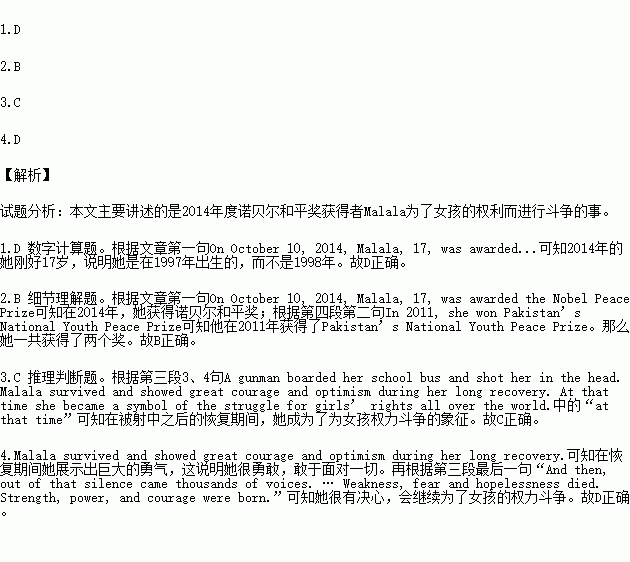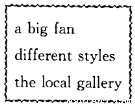题目内容
On October 10, 2014, Malala, 17, was awarded the Nobel Peace Prize for struggling for the right of children to education. Malala is the youngest Nobel winner in history.
Malala Yousafzai has never been ordinary. When she was just 11, she started blogging (写博客) about the Taliban takeover of her hometown of Mingora, Pakistan. Taliban members follow an extreme belief of Islam and forbid girls to go to school. Classrooms were closed for several months. Malala spoke out about her desire to go back to school. “All I want is an education,” she told one television broadcaster.
Malala was later able to return to class. But she continued to blog and speak out about girls’ right to education. On October 9, 2012, the Taliban tried to silence her. A gunman boarded her school bus and shot her in the head. Malala survived and showed great courage and optimism during her long recovery. At that time she became a symbol of the struggle for girls’ rights all over the world. Nine months after she was shot, she gave a now-famous speech at the United Nations. “They thought that the bullets (子弹) would silence us. But they failed,” she said. “And then, out of that silence came thousands of voices. … Weakness, fear and hopelessness died. Strength, power, and courage were born.”
Malala has also become an international symbol for peace. In 2011, she won Pakistan’s National Youth Peace Prize, which is now renamed the National Malala Peace Prize. Malala said the 2014 Nobel Prize was an “encouragement” to go forward to help kids. “I want to tell children all around the world that they should stand up for their rights,” she said. “This award is for all those children whose voices need to be heard.”
1.All the statements about Malala are true EXCEPT that _____.
A. she started blogging at the age of 11
B. it took her a long time to recover from the injury
C. Taliban tried to silence her but failed
D. she was born in1998 in Mingora, Pakistan.
2. How many peace prizes have gone to Malala so far according to the passage?
A.1. B. 2. C. 3. D. 4.
3. When did Malala become a symbol for girls’ rights?
A. When she began writing her blogs.
B. Before Taliban wanted to kill her.
C. During her long recovery after the shot.
D. When she gave a speech in the UN.
4.We can learn from the passage that Malala is _____.
A. creative and outgoing B. strict and stubborn
C. simple and warm-hearted D. brave and determined


